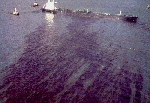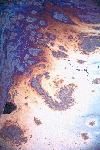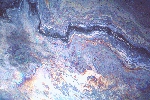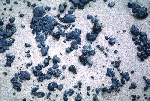| FATE & EFFECTS | ||||||||||||||||
|
| ||||||||||||||||
|
Fate of Marine Oil SpillsOil is a general term used to denote petroleum products which mainly consist of hydrocarbons. Crude oils are made up of a wide spectrum of hydrocarbons ranging from very volatile, light materials such as propane and benzene to more complex heavy compounds such as bitumens, asphaltenes, resins and waxes. Refined products such as petrol or fuel oil are composed of smaller and more specific ranges of these hydrocarbons. 
Oil, when spilled at sea, will normally break up and be dissipated or scattered into the marine environment over time. This dissipation is a result of a number of chemical and physical processes that change the compounds that make up oil when it is spilled. The processes are collectively known as weathering. Oils weather in different ways. Some of the processes, like natural dispersion of the oil into the water, cause part of the oil to leave the sea surface, while others, like evaporation or the formation of water in oil emulsions, cause the oil that remains on the surface to become more persistent. The way in which an oil slick breaks up and dissipates depends largely on how persistent the oil is. Light products such as kerosene tend to evaporate and dissipate quickly and naturally and rarely need cleaning-up. These are called non-persistent oils. In contrast, persistent oils, such as many crude oils, break up and dissipate more slowly and usually require a clean-up response. Physical properties such as the density, viscosity and pour point of the oil all affect its behaviour. Dissipation does not occur immediately. The time this takes depends on a series of factors, including the amount and type of oil spilled, the weather conditions and whether the oil stays at sea or is washed ashore. Sometimes, the process is quick and on other occasions it can be slow, especially in sheltered and calm areas of water. Behaviour of oil at seaThe eight main processes that cause an oil to weather are described below and summarised in the following diagram. Figure 1: Fate of oil spilled at sea showing the main weathering processes Spreading
EvaporationLighter components of the oil will evaporate to the atmosphere. The amount of evaporation and the speed at which it occurs depend upon the volatility of the oil. An oil with a large percentage of light and volatile compounds will evaporate more than one with a larger amount of heavier compounds. For example, petrol, kerosene and diesel oils, all light products, tend to evaporate almost completely in a few days whilst little evaporation will occur from a heavy fuel oil. In general, in temperate conditions, those components of the oil with a boiling point under 200ºC tend to evaporate within the first 24 hours. Evaporation can increase as the oil spreads, due to the increased surface area of the slick. Rougher seas, high wind speeds and high temperatures also tend to increase the rate of evaporation and the proportion of an oil lost by this process. DispersionWaves and turbulence at the sea surface can cause all or part of a slick to break up into fragments and droplets of varying sizes. These become mixed into the upper levels of the water column. Some of the smaller droplets will remain suspended in the sea water while the larger ones will tend to rise back to the surface, where they may either coalesce with other droplets to reform a slick or spread out to form a very thin film. The oil that remains suspended in the water has a greater surface area than before dispersion occurred. This encourages other natural processes such as dissolution, biodegradation and sedimentation to occur. The speed at which an oil disperses is largely dependent upon the nature of the oil and the sea state, and occurs most quickly if the oil is light and of low viscosity and if the sea is very rough. These factors led to the complete dispersion of the oil spilled from the BRAER (Shetland Islands, United Kingdom, 1993). The addition of chemical dispersants can accelerate this process of natural dispersion. Emulsification
An emulsion is formed when two liquids combine, with one ending up suspended in the other. Emulsification of crude oils refers to the process whereby sea water droplets become suspended in the oil. This occurs by physical mixing promoted by turbulence at the sea surface. The emulsion thus formed is usually very viscous and more persistent than the original oil and is often referred to as chocolate mousse because of its appearance. The formation of these emulsions causes the volume of pollutant to increase between three and four times. This slows and delays other processes which would allow the oil to dissipate. Oils with an asphaltene content greater than 0.5% tend to form stable emulsions which may persist for many months after the initial spill has occurred. Those oils containing a lower percentage of asphaltenes are less likely to form emulsions and are more likely to disperse. Emulsions may separate into oil and water again if heated by sunlight under calm conditions or when stranded on shorelines. Dissolution
OxidationOils react chemically with oxygen either breaking down into soluble products or forming persistent compounds called tars. This process is promoted by sunlight and the extent to which it occurs depends on the type of oil and the form in which it is exposed to sunlight. However, this process is very slow and even in strong sunlight, thin films of oil break down at no more than 0.1% per day. The formation of tars is caused by the oxidation of thick layers of high viscosity oils or emulsions. This process forms an outer protective coating of heavy compounds that results in the increased persistence of the oil as a whole. Tarballs, which are often found on shorelines and have a solid outer crust surrounding a softer, less weathered interior, are a typical example of this process. Sedimentation/SinkingSome heavy refined products have densities greater than one and so will sink in fresh or brackish water. However sea water has a density of approximately 1.025 and very few crudes are dense enough or weather sufficiently, so that their residues will sink in the marine environment. Sinking usually occurs due to the adhesion of particles of sediment or organic matter to the oil. Shallow waters are often laden with suspended solids providing favourable conditions for sedimentation. Oil stranded on sandy shorelines often becomes mixed with sand and other sediments. If this mixture is subsequently washed off the beach back into the sea it may then sink. In addition, if the oil catches fire after it has been spilled, the residues that sometimes form can be sufficiently dense to sink. Biodegradation
Sea water contains a range of micro-organisms or microbes that can partially or completely degrade oil to water soluble compounds and eventually to carbon dioxide and water. Many types of microbe exist and each tends to degrade a particular group of compounds in crude oil. However, some compounds in oil are very resistant to attack and may not degrade. The main factors affecting the efficiency of biodegradation, are the levels of nutrients (nitrogen and phosphorus) in the water, the temperature and the level of oxygen present. As biodegradation requires oxygen, this process can only take place at the oil-water interface since no oxygen is available within the oil itself. The creation of oil droplets, either by natural or chemical dispersion, increases the surface area of the oil and increases the area available for biodegradation to take place. Combined processesThe processes of spreading, evaporation, dispersion, emulsification and dissolution are most important during the early stages of a spill whilst oxidation, sedimentation and biodegradation are more important later on and determine the ultimate fate of the oil. To understand how different oils change over time whilst at sea, one needs to know how these weathering processes interact. To predict this, some simple models have been developed based on oil type. Oils have been classified into groups roughly according to their density - generally, oils with a lower density will be less persistent. However some apparently light oils can behave more like heavy ones due to the presence of waxes. One model uses the half-life for a group of oils to describe the persistence and the time needed for the oil to dissipate. The half life is the time needed for 50% of the oil to disappear from the sea surface. After six half-lives have passed, about 1% of the oil will remain. This model, is shown in the illustration below. Weather and climatic conditions will alter the rates shown e.g. in rough weather a group 3 oil may dissipate in a timescale similar to a group 2 oil. Figure 2: The rate of removal of oil from the sea surface according to typeVolume of oil and water-in-oil emulsion remaining on the sea surface is shown as a percentage of the original volume spilled.
Although simple models such as this cannot predict the changes an oil undergoes very precisely, they can provide clues about whether an oil is likely to dissipate naturally or whether it will reach the shoreline. This information can be used by spill responders to decide upon the most effective spill response techniques and whether such techniques can be initiated quickly enough. Further information is available in our Technical Information Paper: Fate of Marine Oil Spills (473Kb) | ||||||||||||||||
 As soon as oil
is spilled, it starts to spread out over the sea surface, initially as a
single slick. The speed at which this takes place depends to a great
extent upon the viscosity of the oil. Fluid, low viscosity oils spread
more quickly than those with a high viscosity. Nevertheless, slicks
quickly spread to cover extensive areas of the sea surface. Spreading is
rarely uniform and large variations in the thickness of the oil are
typical. After a few hours the slick will begin to break up and, because
of winds, wave action and water turbulence, will then form narrow bands or
windrows parallel to the wind direction. The rate at which the oil spreads
is also determined by the prevailing conditions such as temperature, water
currents, tidal streams and wind speeds. The more severe the conditions,
the more rapid the spreading and breaking up of the oil.
As soon as oil
is spilled, it starts to spread out over the sea surface, initially as a
single slick. The speed at which this takes place depends to a great
extent upon the viscosity of the oil. Fluid, low viscosity oils spread
more quickly than those with a high viscosity. Nevertheless, slicks
quickly spread to cover extensive areas of the sea surface. Spreading is
rarely uniform and large variations in the thickness of the oil are
typical. After a few hours the slick will begin to break up and, because
of winds, wave action and water turbulence, will then form narrow bands or
windrows parallel to the wind direction. The rate at which the oil spreads
is also determined by the prevailing conditions such as temperature, water
currents, tidal streams and wind speeds. The more severe the conditions,
the more rapid the spreading and breaking up of the oil. 
 Water soluble
compounds in an oil may dissolve into the surrounding water. This depends
on the composition and state of the oil, and occurs most quickly when the
oil is finely dispersed in the water column. Components that are most
soluble in sea water are the light aromatic hydrocarbons compounds such as
benzene and toluene. However, these compounds are also those first to be
lost through evaporation, a process which is 10 -100 times faster than
dissolution. Oil contains only small amounts of these compounds making
dissolution one of the less important processes.
Water soluble
compounds in an oil may dissolve into the surrounding water. This depends
on the composition and state of the oil, and occurs most quickly when the
oil is finely dispersed in the water column. Components that are most
soluble in sea water are the light aromatic hydrocarbons compounds such as
benzene and toluene. However, these compounds are also those first to be
lost through evaporation, a process which is 10 -100 times faster than
dissolution. Oil contains only small amounts of these compounds making
dissolution one of the less important processes. 